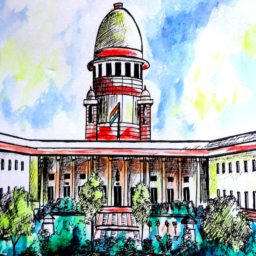INTRODUCTION
A Latin term that simply means ‘a prescription should not run against one who is unable to act’ is, ‘contra non valentem agere nulla currit praescriptio.’[1]
It is a well-established fact that the aggrieved party loses his or her right of legal remedy after the statute of limitations has expired. They have their right to recovery, but their right to remedy is gone. This is founded on the idea that the law favours those who are diligent and do not sleep on their rights. “Often it is said that if a man neglects to exercise his rights, he cannot sue if, after a while, the law follows his example,” Oliver Wendell Holmes said over a century ago.”[2]
The word prescription refers to a property owner’s acquisition of a title or right in the manner prescribed by statute. The “Law of Limitation” establishes a time limit for filing various lawsuits during which an aggrieved party may seek relief from the court. Both words refer to the extinction of a claim or a right, but prescription happens to be more expansive because it provides for the acquisition of rights.[3]
In certain cases, however, the legal provision of terms of limitations cannot be used against a petitioner. In four cases, the contra non valentem tolls prescription is used:
- Where a legal cause prevented the courts or their officers from taking cognizance of or acting on the plaintiff’s action;
- Where a condition attached to a contract or connected with the proceedings prevented the creditor from suing or acting;
- Where a legal cause prevented the courts or their officers from taking cognizance of or acting on the plaintiff’s action;
- Where the appellant is unaware of or sufficiently unaware of a cause of action, even though the defendant is not to blame for his ignorance.[4]
These categories help courts to consider the fairness of the situation of each case when deciding whether a prescription should be tolled.[5] Medical malpractice cases have been observed under the third and fourth categories. A person whose ignorance of his cause of action or inability to assert it is the result of his mental incapacity cannot claim the benefits of this rule unless he has been interdicted.[6]
The fourth category differs somewhat from the first three. In the first three, the appellant was prohibited from executing it due to circumstances outside his control, while the fourth form refers to the plaintiff’s ignorance of the cause of action.
However, if the complainant’s ignorance is due to his wilfulness or neglect or any other personal reason[7], the principle will not recognize his argument from the running of the prescription.[8]
The creditor or appellant bears the burden of proving the suspension of a prescription under the maxim.[9]
Background of The Maxim
Contra non valentem appears to have originated as a gloss.[10] This maxim has its origins in Roman law. Various Roman laws, such as the exceptio doli et malus, dies utiles, and restitutio in integrum, were used by medieval historians to infer the concept of contra non valentem. The Romans had no general code, instead of relying on a combination of special laws and praetorian edicts. [11]
Few still accept that the French doctrine and jurisprudence saved Contra non valentem from the revolutionary guillotine of the Code Civil. [12] The evidence of its roots or historical origin is not further explored by contemporary writers.
Application Of The Maxim
Prescription is most often used in civil law, whereas limitation is the concept used in common law jurisdictions. Prescriptions are binding on all people and are not suspended until the legal provisions for termination are met. Except in the cases specified by statute, minors and people under interdiction cannot be prescribed against.” As a result, a minor cannot bring a lawsuit to defend his interests, because the prescriptive term begins only after he reaches the age of majority. The Limitation Act, 1963, provides for the expiration of prescription after a certain period under Indian law. The maxim is an exception to this.
Cases Referred
This maxim has been followed by Indian courts in the following cases.
- Ganda Singh and Ors. v. Ram Narain Singh
Facts: Mal Singh died leaving 150 bighas of agricultural land. The position then was that the appellants who are the collaterals of Samund Singh were in actual possession of about 19 bighas of land and they were entered as owners of this area. He had inherited this land from his father Gurmukh Singh who had obtained it using a gift from his father-in-law, Samund Singh. The suit was dismissed, but when the matter came up in appeal to the High Court the plaintiffs sought to raise the plea of adverse possession. The actual possession of the land was with the defendants because the original mortgage was a mortgage with possession.
Judgment: The court held that even if, there had been dispossession of the mortgagees by a stranger, that would not have been treated as equivalent to an adverse possession as against Gujjar Singh who during the pendency of the mortgage, was merely entitled to bare equity of redemption.[13] The District Judge took the view that the plaintiffs ought not to be allowed to succeed on the plea of adverse possession. No plea of adverse possession for a period of twelve years was made in the plaint, but the plea was raised in the trial Court itself. A person who claims adverse possession must show on what date he came into possession, what was the nature of his possession? Whether the factum of his possession was known to the legal claimants, and how long his possession continued.
Reasoning: No plea of adverse possession for a period of twelve years was made in the plaint, but the plea was raised in the trial Court itself. Gujjar Singh, given the terms of this mortgage, can well rely upon the maxim Contra non valentem agree nulla currit praescriptio – prescription does not run against a party who is unable to act.
- Devaki Amma Mookambi Amma v. Meenakshy Amma Vijayamma and Anr.
Facts: The appellant is the first claimant in an action for declaration of title and restitution of possession. The appellant and the first defendant are also related to each other. The plaintiff’s mother and brother sent notices from the Revenue Divisional Officer in 1969, stating that if the land was left uncultivated, the government would take ownership. The lower courts agreed that the first defendant obtained custody of the plaint contested object in 1956 and maintained possession afterward. However, on appeal, the Sub-Court ruled that the appellant possessed the title. The appellant is challenging the judgment and order in question.
Judgment: The plaintiff’s right to retain his ownership of the assets assigned to his share occurred soon after the injunction was issued on July 30, 1962. Any infringement of his right of ownership will only be lawfully secured in a Court of Law after the Court’s decree under Section 17 of the Arbitration Act, not before. The clock began ticking against the plaintiff in 1962, and the ownership of the first claimant, which was averse to the plaintiff, before the filing of the suit on December 20, 1971, was insufficient to meet the 12-year requirement for possessing prescriptive title. As a result, the lower court made the correct decision in dismissing the case. In the Second Appeal, there is no need to intervene.[14] The Second Appeal is dismissed with no costs.
Reasoning: No prescription runs against an individual who is unable to bring an action, according to the Maxim “Contra non valentem agere nulla currit prescription.” The time for prescribing a title through adverse possession does not begin until the person entitled to immediate possession is lawfully able to sustain an action to secure his possession. These rules, as stated in the preceding rulings, extend to the facts of this case.
CONCLUSION
The principles of prescription have helped jurists on resolving questions, assisting good judgment, and enhancing the argument. The rule of prescription has a high degree of certainty for clear and well-known reasons. Time dulls witnesses’ memories, ruins testimony, and places unnecessary pressures on litigants through their attempts to prepare their case and recover the facts as they were in the distant past. Except under extraordinary cases and with sufficient jurisdiction should courts exceed the time limit. This would also prevent from lagging the case for various years and make the justice delivery faster. The practice of limitation and prescription has been followed and should be continued further.
Author(s) Name: Jinal Prajapat (Damodaram Sanjivayya National Law University, Visakhapatnam)
References:
[1] Carter v Haygood 892 So.2d 1261, 1268 (La. 2005)
[2] O H Holmes, ‘The path of the law’ (1897) Harvard Law Review, 476
[3] Douglas Nichols, ‘Contra Non Valentem’ (1995) 56 La L Rev 337
[4] Ejh Schrage, ‘Contra Non Valentem Agere, Non Currit Praescriptio – the Failure to Comply with Statutory Time-Limits Deprives a Potential Claimant of His Claim, or Does It’ (2012) J S Afr L 1
[5] Supra 1
[6] Israel v Smith 302 So. 2d 392 (La.App. 3 Cir. 1974)
[7] Ayres v New York Life Ins. Co. 219 La. 945, 54 So. 2d 409 (1951)
[8] Cartwright v Chrysler Corporation 255 La. 597, 598, 232 So. 2d 285 (1970)
[9] Johnson Controls Inc. v Lynch 633 So.2d 212 (La.App. 1st Cir.1993)
[10] Supra 3
[11] Ibid
[12] Ibid
[13] Ganda Singh and Others v Ram Narain Singh AIR 1959 Punj. 147
[14] Devaki Amma Mookambi Amma v Meenakshy Amma Vijayamma and Anr. 1989 SCC Online Ker 159














